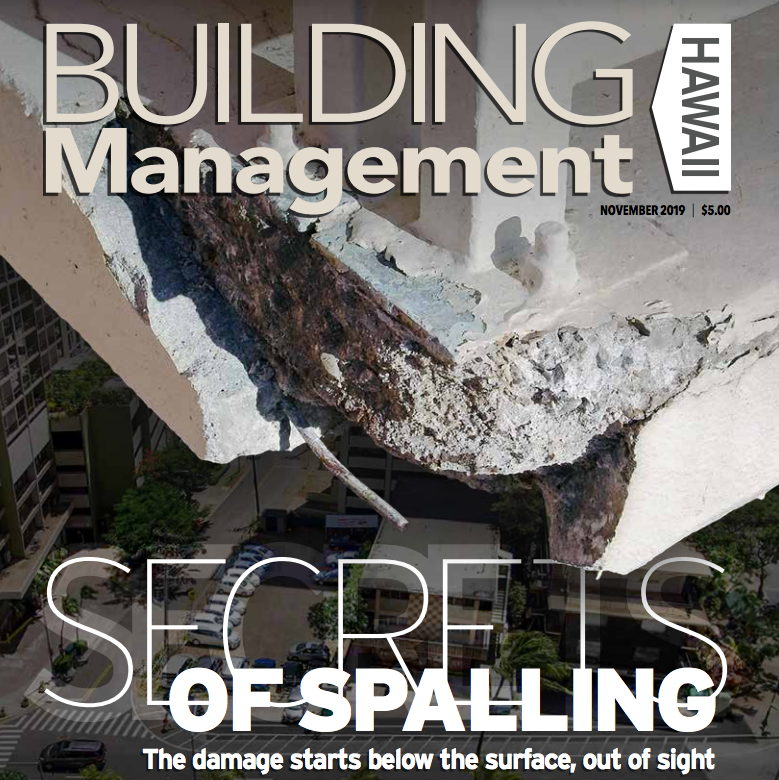Concrete is the most widely used building material in the world, and if designed and installed properly it has close to an indefinite lifespan. Concrete is versatile; it will conform to virtually any shape it is placed in, allowing for creativity in design and durability. Its simplicity ends here. Concrete is subject to damage and deterioration by a number of mechanisms whether it be mechanical damage caused by impacts, cracking or leaning due to earthquakes, damage due to environmental exposures such as chemical attacks, or damage due to improper placement of reinforcing steel.
As the owner/operator of a property you need to promptly act to mitigate damage so that the appearance and value of the property is maintained and to ensure you have safe premises for guests and employees.
I. Concrete damage and walkway patches of cracks
One of the most obvious aspects of concrete damage is cracking of the flatwork. Cracks are often caused by a combination of poor construction and soils movement.
If there is mechanical damage causing a spall, a mere patch of additional concrete will often not result in a lasting repair. Generally, the area of the damage should be cut out and a new section of slab placed. So that a good visual appearance is maintained, it is important to consider the size of the cut-out due to a potential mismatch in color and appearance.
If there is vertical displacement or a raised crack, the initial repair is often grinding of the two adjacent surfaces until there is a smooth transition. This will prevent a trip hazard, whether by a heel getting caught in the crack or a toe of the shoe tripping over the raised concrete.
Grinding is typically viewed as a temporary measure, and eventually slab replacement is necessary. Simply replacing one slab section is merely a band aid and does not provide a remedy for the underlying issue. Cracks are often caused by expansive soil, which are common here on the Islands. There may not be an adequate thickened edge on the slab to provide a stronger foundation and barrier the moisture movements. Verify that adjacent planters and lawns are not being subjectable to uneven moisture conditions.
II. Spalling of tops of walls, fences, and even benches
It is not uncommon to see spalling or the breaking off of concrete chunks along the tops of walls or fences. This is not the failure of the concrete cracks but rather corrosion of the embedded steel. Often the rebar which reinforces the concrete is placed too close to the surface of the concrete and is not protected from moisture intrusion. As concrete is porous and allows water to pass. A patch over these areas will do no good and the damaged section will need to be replaced. The damaged section needs to be carefully examined to make sure structural integrity of the concrete section has not been compromised; and that a patch can be properly integrated into the wall.
If the cracking is occurring along the length of a concrete post which supports a fence, or along the railing of a fence, it is highly likely that the cracks had adversely affected the integrity of the post, creating a significant failure hazard. Railing failures have happened here in Hawaii whether it be the corrosion of a metal post embedded in the concrete or spalling of concrete adjacent to the post, guardrails can and will fail. What could be viewed as a simple bench, can be a major source of potential liability. If it fails when a couple sits on it there can be severe and potential danger.
The ocean breeze brings chlorides in the mist. Chlorides accelerate corrosion; and once the embedded steal or rebar corrode it effectively cannot be stopped once it begins. The rusting steel occupies up to six times the volume and literally breaks the concrete apart, spalls occur, resulting in chunks of concrete falling off, often exposing the rusty steel beam. If not caught early enough the integrity of the structure is compromised.
III. Chemical – Attack to Concrete
Soils can have corrosive levels of chemicals in them. Whether due to irrigation or rainfall, water enters in to the soil and dissolves chlorides or sulfates deposits or the residue of chemical fertilization, or sometimes both, all of which we have here in Hawaii. We often find sulfates of magnesium or sodium in the soils; the soluble and get into the concrete through the inherent porosity of most concrete mixes. Unless a foundation is totally isolated by a thick plaster membrane; with no holes or punctures and raised all the way to the top of the foundation above the spoil; the soil gets into the concrete dissolving a portion of the cement matrix and forming new crystal deposits inside the concrete, causing initial cracks, which often spalling of the outside edge. This continues until the concrete is compromised.
IV. Physical salt attack
Here on the Islands, some consider what we really have only two seasons, Day and Night. At night the temperature drops and during the day the sun heats on the concrete surfaces drawing moisture up through the concrete all day, causing crystals to form onto exterior edges, spalling off smaller layers of concrete. Day by day – year by year- the spalling which starts as fine or map cracks which can damage the concrete surface. Eventually a repair is necessary.
 Ken Kasdan is considered one of the nation’s leading construction defect authorities. He regularly speaks at national conventions of attorneys, insurers and claims professionals. He has practiced law for over forty years. He is the Senior Partner with Kasdan LippSmith LLLC, a fully staffed firm with its primary office in Oahu. He and his Director of Client Relations, Louisa Percudani can be reached at (808) 369-8393. Kllawhawaii.com
Ken Kasdan is considered one of the nation’s leading construction defect authorities. He regularly speaks at national conventions of attorneys, insurers and claims professionals. He has practiced law for over forty years. He is the Senior Partner with Kasdan LippSmith LLLC, a fully staffed firm with its primary office in Oahu. He and his Director of Client Relations, Louisa Percudani can be reached at (808) 369-8393. Kllawhawaii.com


